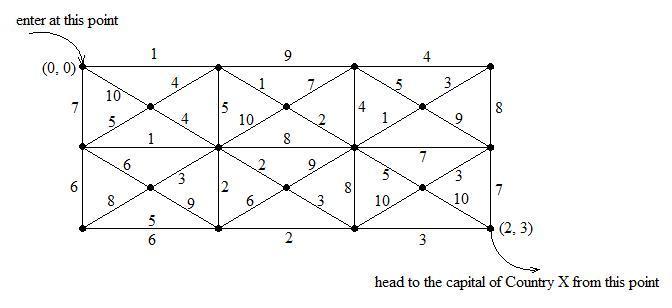hdu 3035 War(平面图最小割)
2014-03-18 00:07
316 查看
War
Time Limit: 20000/10000 MS (Java/Others) Memory Limit: 65536/65536 K (Java/Others)Total Submission(s): 1128 Accepted Submission(s): 301
[align=left]Problem Description[/align]
Country X is under attack by enemies. Now the army of enemy has arrived at City Y. City Y consists of an N×M grid. All the paths in the grid are bidirectional, horizontal or vertical or diagonal. The upper-left corner is (0, 0) and
lower-right corner is (N, M). The army enters at (0, 0) and they must get to (N, M) in order to continue their attack to the capital of Country X. The figure below shows what does City Y looks like.

Every blackened node represents a vertex. The number beside each edge is the amount of TNT needed to destroy that road. The army of Country X is unable to beat the enemy now. The only thing they can do is to prevent them from heading to their capital so that
they can have more time to prepare for striking back. Of course they want to use the least amount of TNT to disconnect (0, 0) and (N, M). You are a talented programmer, please help them decide the least amount needed.
[align=left]Input[/align]
There are multiple test cases.
The first line of each test case contains two positive integers N and M, representing height and width of the grid.
Then N+1 lines each containing M integers, giving you the amount needed of horizontal roads in row major order.
Then N lines each containing M+1 integers, giving you the amount needed of vertical roads in row major order.
Then 2N lines each containing 2M integers, giving you the amount needed of diagonal roads in row major order.
There is a blank line after each input block. The sample input is corresponding to the figure above.
Restriction:
1 <= N, M <= 500
1 <= amount <= 1,000,000
[align=left]Output[/align]
One line for each test case the least amount of TNT needed to disconnect (0, 0) and (N, M).
[align=left]Sample Input[/align]
2 3 1 9 4 1 8 7 6 2 3 7 5 4 8 6 2 8 7 10 4 1 7 5 3 5 4 10 2 1 9 6 3 2 9 5 3 8 9 6 3 10 10
[align=left]Sample Output[/align]
18 求无向图的最小割,转化为求最短路径,参考点击打开链接,要建平面图的对偶图,建图十分麻烦。。。 AC代码:[code]#include <iostream> #include <cmath> #include <cstdlib> #include <cstring> #include <cstdio> #include <queue> #include <stack> #include <ctime> #include <vector> #include <algorithm> #define ll long long #define L(rt) (rt<<1) #define R(rt) (rt<<1|1) #define eps 1e-6; using namespace std; const int INF = 1e9; const int maxn = 1000005; struct Edge{ int v, w, next; }et[maxn * 3]; int n, m, s, t, num; int dis[maxn], eh[maxn]; bool vis[maxn]; typedef pair<int,int> pii; void init(){ memset(eh, -1, sizeof(eh)); num = 0; } void add(int u, int v, int w){ Edge e = {v, w, eh[u]}; et[num] = e; eh[u] = num++; } int dij(){ priority_queue<pii, vector<pii>, greater<pii> >Q; memset(vis, false, sizeof(vis)); for(int i = 0; i <= t; i++) dis[i] = INF; dis[s] = 0; Q.push(pii(dis[s], s)); while(!Q.empty()) { pii x = Q.top(); Q.pop(); int u = x.second; if(vis[u]) continue; vis[u] = true; for(int i = eh[u]; i != -1; i = et[i].next) { int v = et[i].v, w = et[i].w; if(dis[v] > dis[u] + w) { dis[v] = dis[u] + w; Q.push(pii(dis[v], v)); } } } return dis[t]; } int main() { int u, v, w; while(~scanf("%d%d", &n, &m)) { init(); s = 0; t = 4 * n * m + 1; for(int i = 1; i <= m; i++) { scanf("%d", &w); add(s, i, w); add(i, s, w); } for(int i = 1; i < n; i++) for(int j = 1; j <= m; j++) { scanf("%d", &w); u = i * 2 * m + j; v = u - m; add(u, v, w); add(v, u, w); } for(int i = 1; i <= m; i++) { scanf("%d", &w); u = 2 * n * m - m + i; add(u, t, w); add(t, u, w); } int cnt = n * m * 2; for(int i = 1; i <= n; i++) for(int j = 1; j <= m + 1; j++) { scanf("%d", &w); if(j == 1) { u = cnt + (i - 1) * 2 * m + j; add(u, t, w); add(t, u, w); } else if(j == m + 1) { u = cnt + (i - 1) * 2 * m + 2 * m; add(u, s, w); add(s, u, w); } else { u = cnt + (i - 1) * 2 * m + (j - 1) * 2; v = u + 1; add(u, v, w); add(v, u, w); } } for(int i = 1; i <= 2 * n; i++) for(int j = 1; j <= 2 * m; j++) { scanf("%d", &w); u = (i - 1) * m + (j + 1) / 2; v = cnt + j + ((i + 1) / 2 - 1) * 2 * m; add(u, v, w); add(v, u, w); } printf("%d\n", dij()); } return 0; }
[/code]
相关文章推荐
- HDU 3035 War 平面图最小割转化为最短路
- HDU 3035 War(对偶图求最小割)
- HDU 3035 War 平面最小割+优先队列优化的dij
- 【HDU】3035 War 对偶图最小割——最短路
- HDU 2435 There is a war(修改或添加一条边的最小割 )经典
- HDOJ3035平面图最小割转最短路
- HDU 2435 There is a war (网络流-最小割)
- 平面图s-t最小割 HDU 3870 Catch the Theves
- HDU-3035-War
- HDU 2435 There is a war (网络流-最小割)
- HDU 3870 Catch the Theves(平面图最小割转最短路径)
- HDU - 3035 War(对偶图+最小割+最短路)
- HDU 2435 There is a war (网络流-最小割)
- There is a war (hdu 2435 最小割+枚举)
- hdu 3870(平面图最小割转最短路)
- HDU 3035 War (对偶图转最短路)
- 平面图ST最小割(hdu 3870)
- hdu 2435 There is a war 最小割
- hdu 1599 find the mincost route floyd求最小环
- hdu 3374 最小表示法加 KMP
